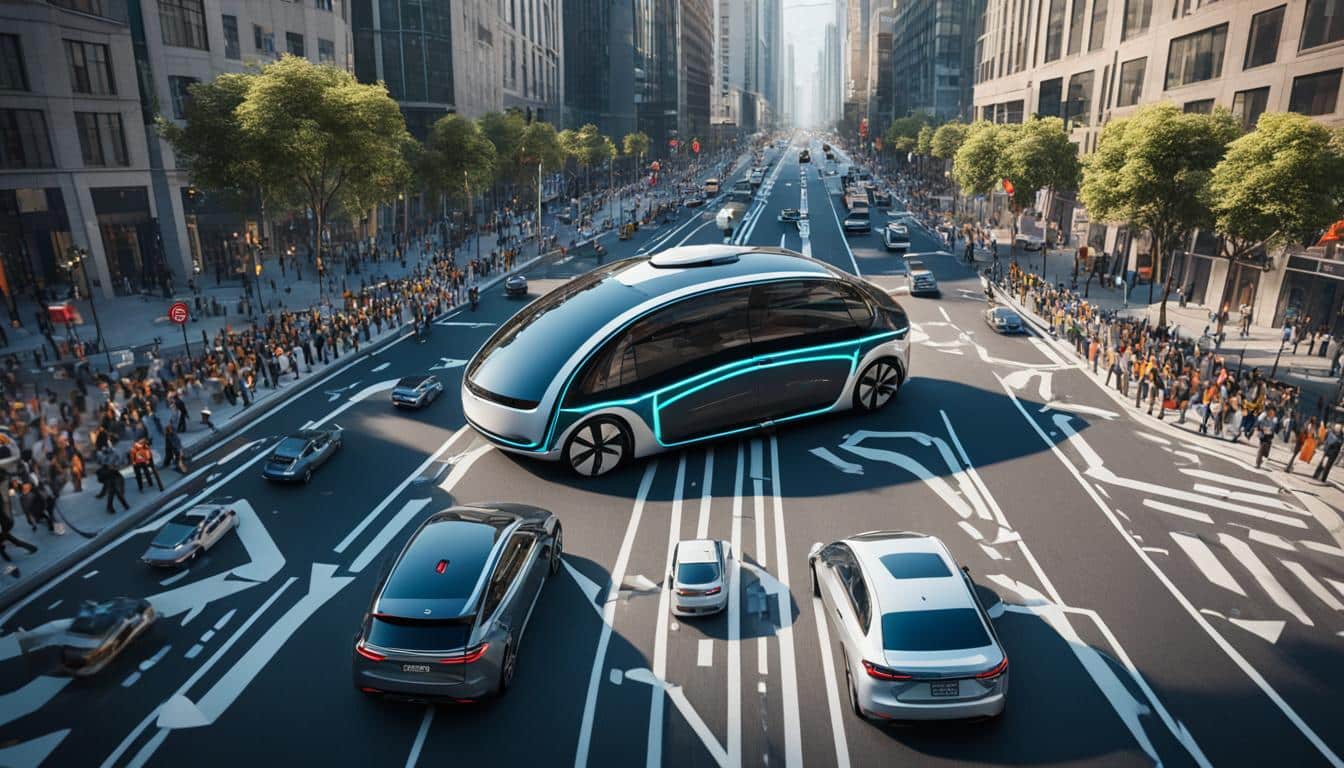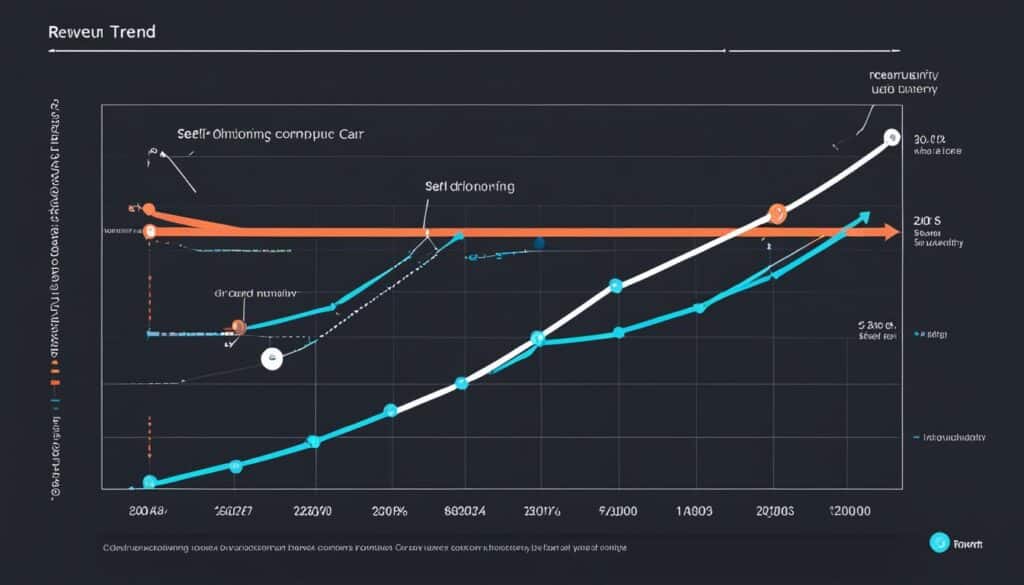
Overcoming Challenges in the Self-Driving Car Industry
I, as a journalist covering the advancements in the self-driving car industry, have witnessed firsthand the challenges that this emerging technology faces. From traffic management to infrastructure requirements, from generating revenue to dealing with liability insurance and police and emergency responses, the self-driving car industry has a lot to tackle in order to achieve its full potential.
Key Takeaways:
- The self-driving car industry is grappling with various challenges such as traffic management, infrastructure requirements, revenue generation, liability insurance, and police and emergency response considerations.
- Efficient traffic management is crucial for the successful integration of self-driving vehicles into existing transportation systems, taking into account the impact on traffic flow efficiency and the need for data-driven traffic management strategies.
- Infrastructure requirements, including clear lane striping, data storage capabilities, and a robust charging network, are essential for the smooth operation of autonomous vehicles.
- The introduction of self-driving vehicles will require cities to find alternative revenue streams to replace the income previously generated from traffic fines.
- The issue of liability and insurance is complex in the self-driving car industry, necessitating the development of informed policies that determine responsibility in the event of accidents or damages.
- Law enforcement and emergency response departments must adapt to the presence of autonomous vehicles through proper training and coordination to ensure public safety.
Traffic Management Challenges
One of the challenges in the self-driving car industry is effectively managing traffic. While self-driving vehicles can potentially improve traffic flow efficiency, there is a concern that if they become available too quickly, it may lead to more personal vehicles on the road, which could lead to longer commutes and disincentivize the use of public transportation. Self-driving trucks and shuttles can also help alleviate traffic issues, but proper data collection and analysis are crucial for optimizing traffic patterns.
Seattle’s Advances Traffic Management System (ATMS) has the capability to collect on-street traffic data, and integrating AV traffic data into this system can help improve traffic management strategies.
By analyzing real-time traffic data from self-driving vehicles, the Advances Traffic Management System can make more informed decisions to reduce congestion and improve overall traffic flow efficiency for all road users.
The Benefits of Self-Driving Trucks and Shuttles
The introduction of self-driving trucks and shuttles presents an opportunity to enhance traffic management. These autonomous vehicles have the potential to:
- Optimize delivery routes and schedules, reducing congestion caused by inefficient transportation of goods
- Enable platooning, where trucks drive closely together, decreasing wind resistance and improving fuel efficiency
- Provide reliable and convenient shuttle services, encouraging people to choose shared transportation over personal vehicles
However, to fully leverage the benefits of self-driving trucks and shuttles, accurate and up-to-date traffic data is vital. This data can help identify areas of high congestion, plan efficient routes, and enable dynamic adjustments based on real-time conditions.
Improving Traffic Management Strategies
The integration of self-driving vehicles into the Advances Traffic Management System enables a comprehensive approach to traffic management. By combining data from autonomous vehicles with existing traffic data, transportation authorities can:
- Monitor and control traffic flow in real time, adjusting traffic signal timings and lane configurations to maximize efficiency
- Predict and mitigate potential congestion hotspots, allowing proactive measures to be taken to prevent traffic buildup
- Optimize traffic signal synchronization to minimize stop-and-go traffic, reducing greenhouse gas emissions and fuel consumption
- Enable dynamic rerouting of self-driving vehicles to keep traffic flowing smoothly during incidents or road closures
With the Advances Traffic Management System leveraging traffic data from self-driving vehicles, cities can stay ahead of the increasing demand for mobility and ensure optimal traffic flow for both autonomous and traditional vehicles.
| Benefits | Challenges |
|---|---|
| Improved traffic flow efficiency | Increase in personal vehicles on the road |
| Enhanced delivery routes and schedules | Accurate and up-to-date traffic data collection and analysis |
| Platooning for fuel efficiency | Integration of self-driving vehicle data into traffic management systems |
| Convenient and reliable shuttle services | Ongoing coordination between transportation authorities and self-driving vehicle manufacturers |
Infrastructure Challenges
As autonomous vehicles continue to gain traction in the self-driving car industry, there are several infrastructure challenges that need to be addressed. These challenges include lane striping, data storage, and charging network requirements, as well as the importance of community and industry outreach and public investments.
Lane Striping
Clear and properly marked lane striping is crucial for the safe and efficient operation of self-driving vehicles. Autonomous vehicles rely on lane markings to navigate the roads and make informed decisions. However, lane striping can be a challenge in areas with aging infrastructure, unclear or faded markings, or inclement weather conditions. It is essential for cities and transportation departments to prioritize regular maintenance and ensure that lane striping is clear and visible.
Data Storage
Autonomous vehicles collect vast amounts of data during their operation, including sensor readings, video feeds, and navigation information. This data plays a critical role in improving the performance and safety of self-driving cars. Therefore, it is important to establish robust data storage systems that can securely store and process this information. Adequate data storage infrastructure can contribute to enhancing vehicle capabilities and refining self-driving algorithms.
Charging Network
Electric autonomous vehicles require a reliable and extensive charging network to support their operations. Building a charging infrastructure that caters to the charging needs of self-driving cars is essential in promoting the adoption of electric and sustainable transportation. This includes the installation of charging stations in strategic locations such as parking lots, highways, and other areas with high vehicle traffic.
Community and Industry Outreach
Engaging with both the community and industry stakeholders is crucial when planning for the infrastructure needs of autonomous vehicles. Community outreach can help understand the specific requirements and concerns of local residents, while industry outreach allows for collaboration with technology companies and automotive manufacturers to ensure that infrastructure is compatible with autonomous vehicle systems. By involving all stakeholders, it is possible to create a comprehensive plan that addresses the infrastructure challenges effectively.
Public Investments
Addressing the infrastructure challenges of self-driving cars requires significant public investments. Municipalities and governments need to allocate resources to upgrade existing infrastructure and develop new features that cater to the specific requirements of autonomous vehicles. These investments should prioritize safety, efficiency, and sustainability to create an environment conducive to the growth and integration of self-driving cars.
Revenue Challenges
The introduction of self-driving vehicles poses significant revenue challenges for cities, particularly in relation to traffic fines. Currently, traffic fines contribute a substantial amount to the city’s operating fund. However, with autonomous vehicles’ ability to precisely follow traffic regulations, there will likely be a decrease in traffic violations and subsequent fines.
This decline in traffic fines creates a need for cities like Seattle to explore alternative revenue streams to compensate for the loss. Implementing new measures such as a mileage tax or an AV registration tax could help generate the necessary funds. These taxes would provide a means for the city to recover revenue that was previously obtained through traffic fines.
Let’s take a closer look at the potential alternative revenue streams:
| New Revenue Streams | Description |
|---|---|
| Mileage Tax | A tax levied based on the number of miles driven by self-driving vehicles. This tax would account for the wear and tear on roads and infrastructure caused by increased autonomous vehicle usage. |
| AV Registration Tax | A tax imposed on the registration of autonomous vehicles. This tax would provide a direct revenue source from the ownership of self-driving vehicles and could help offset the loss of income from traffic fines. |
By implementing these new revenue streams, cities can ensure that the introduction of self-driving vehicles does not have a negative impact on the city’s financial stability. The revenue generated from these taxes could be allocated towards infrastructure improvements, public transportation enhancements, or other city initiatives.

In conclusion, while the decrease in traffic fines may pose revenue challenges for cities, exploring alternative revenue streams such as mileage tax and AV registration tax can help compensate for the loss. It is crucial for cities to adapt to the changing landscape of transportation and find innovative ways to generate revenue to support their operations and services.
Liability Insurance Challenges
The issue of liability and insurance is a major challenge in the self-driving car industry. As autonomous vehicles become more prevalent on our roads, it becomes crucial to determine who is responsible in the event of accidents or damages caused by these vehicles.
Unlike traditional car accidents, where driver error is often to blame, fender benders involving self-driving cars raise new questions. With the vehicle itself assuming control, it introduces a complex dynamic of liability. Insurance companies will need to adapt their policies to account for scenarios where the vehicle is in control, and the driver may not be actively engaged in driving.
To address these challenges, establishing partnerships between autonomous vehicle companies and communities can play a vital role. By collaborating, communities and companies can work together to develop informed liability policies that consider the unique risks and circumstances presented by self-driving technology.
City officials also have a responsibility to stay informed about the ever-evolving landscape of liability policies. By keeping abreast of the latest developments and engaging in ongoing dialogue, they can ensure the smooth integration of self-driving vehicles into the transportation system.

Fostering Community Partnerships
One effective way to navigate the liability insurance challenges is through community partnerships. Collaborating with local communities allows autonomous vehicle companies to gain insights into the specific concerns and needs of residents.
“By working hand in hand with communities, autonomous vehicle companies can develop policies that not only protect the interests of all stakeholders but also foster trust and acceptance of this emerging technology,” says Sarah Johnson, a transportation consultant.
These partnerships enable community leaders and autonomous vehicle companies to exchange valuable information and insights. By listening to the community’s input and addressing their concerns, liability policies can be tailored to reflect the unique characteristics of each region.
Informed Liability Policies
Developing liability policies that are well-informed and comprehensive is crucial for the responsible deployment of self-driving cars. A key consideration is ensuring that insurance coverage adequately accounts for accidents or damages resulting from autonomous vehicle control.
- Clear guidelines for determining fault in accidents involving self-driving cars
- Adapting insurance policies to cover accidents caused by technical malfunctions
- Assessing the level of human control required in different driving scenarios
“Informed liability policies should strike a balance between holding manufacturers accountable for vehicle performance and ensuring that drivers also bear some responsibility for maintaining control of the vehicle,” explains Michael Anderson, CEO of SafeDrive Insurance.
These policies must be continually reviewed and adapted as technology advances and autonomous driving capabilities evolve.
Police and Emergency Response Challenges
The implementation of self-driving vehicles presents unique challenges for law enforcement and emergency response departments. As autonomous vehicles become more prevalent on our roads, it is crucial for police officers and emergency service providers to be equipped with the necessary skills and procedures to effectively interact with these vehicles in various situations.
Law enforcement officers may require specialized training to recognize and interact with autonomous vehicles during routine traffic stops or emergency scenarios. This training should cover the protocols for safely approaching and communicating with connected AVs to ensure the safety of both officers and the occupants of self-driving vehicles.
Furthermore, close collaboration between law enforcement agencies and autonomous vehicle manufacturers is essential in developing effective protocols and strategies for identifying and dealing with self-driving vehicles. This partnership can facilitate the seamless integration of autonomous vehicles into existing law enforcement processes and foster a better understanding of the capabilities and limitations of these vehicles.
In addition to law enforcement, emergency service providers can benefit from coordinated efforts with self-driving vehicles. Leveraging the capabilities of autonomous vehicles in surveillance and dispatch operations can enhance the efficiency and effectiveness of emergency response efforts. By working together, emergency services and self-driving vehicle manufacturers can develop protocols and procedures for improved coordination, ultimately leading to more efficient and timely emergency services.
While there are clear benefits to incorporating self-driving vehicles into law enforcement and emergency response operations, it is crucial for city officials to also consider the potential drawbacks and challenges. The reliance on autonomous technology introduces new complexities and risks that require careful consideration. City officials must weigh the benefits of improved response times and coordination against the potential challenges related to liability and accountability in incidents involving self-driving vehicles.
In conclusion, the adoption of autonomous vehicles presents both opportunities and challenges for law enforcement and emergency response departments. Training procedures, collaboration between law enforcement and autonomous vehicle manufacturers, and coordination between emergency services and self-driving vehicles are essential components in successfully navigating these challenges. By embracing this technology and developing effective strategies, law enforcement and emergency response agencies can leverage the benefits of self-driving vehicles to enhance public safety and response capabilities.
FAQ
What are the main challenges facing the self-driving car industry?
The self-driving car industry is facing challenges in traffic management, infrastructure requirements, revenue generation, liability insurance, and police and emergency response.
How can self-driving vehicles affect traffic management?
While self-driving vehicles can potentially improve traffic flow efficiency, there is a concern that their rapid deployment may lead to more personal vehicles on the road, resulting in longer commutes and decreased use of public transportation. Self-driving trucks and shuttles can help alleviate traffic issues, but proper data collection and analysis are crucial for optimizing traffic patterns.
What infrastructure challenges are associated with self-driving vehicles?
Autonomous vehicles require clear lane striping, storage capabilities for collected data, and a robust charging network for electric-powered cars. Proper planning, communication, and community engagement are crucial for prioritizing public investments in infrastructure and determining if any expansions or new features are necessary.
How can cities compensate for the decrease in revenue from traffic fines due to autonomous vehicles?
In order to counteract the loss of funding from traffic fines, cities like Seattle may need to explore alternative revenue streams such as implementing a mileage tax or an AV registration tax.
What challenges arise in terms of liability and insurance in the self-driving car industry?
Determining liability in accidents or damages caused by autonomous vehicles is complex. Insurance companies need to adapt policies to handle scenarios where the vehicle is in control and the driver may not be paying attention. Establishing partnerships between autonomous vehicle companies and communities can facilitate the development of liability policies that address these concerns.
What challenges do law enforcement and emergency response departments face with the implementation of self-driving vehicles?
Law enforcement officers may need special training and procedures to interact with self-driving vehicles during routine traffic stops or emergency situations. Cooperation between law enforcement agencies and autonomous vehicle manufacturers is crucial for creating protocols to identify and deal with connected AVs. Additionally, coordinating with self-driving vehicles can benefit emergency services for surveillance and dispatch purposes.
